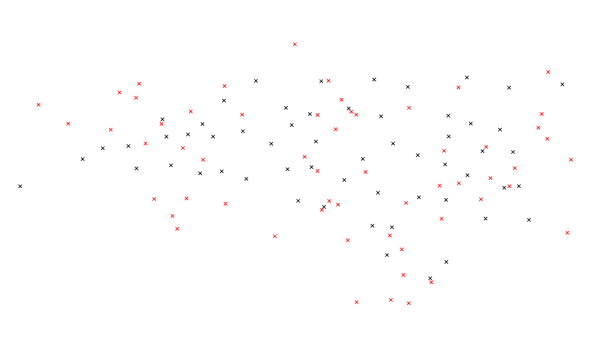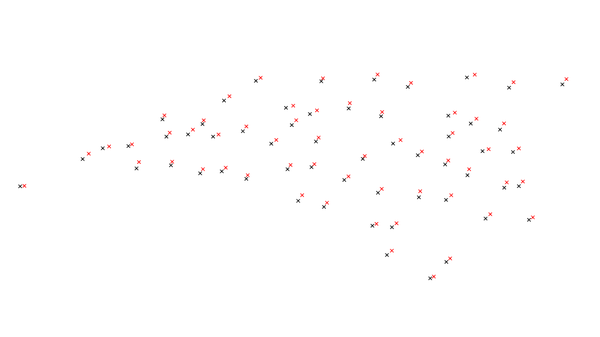v.perturb
Random location perturbations of vector points.
v.perturb [-sb] input=name [layer=string] output=name [distribution=string] parameters=float [,float,...] [minimum=float] [seed=integer] [--overwrite] [--verbose] [--quiet] [--qq] [--ui]
Example:
v.perturb input=name output=name parameters=0.0 seed=0
grass.script.run_command("v.perturb", input, layer="-1", output, distribution="uniform", parameters, minimum=0.0, seed=None, flags=None, overwrite=None, verbose=None, quiet=None, superquiet=None)
Example:
gs.run_command("v.perturb", input="name", output="name", parameters=0.0, seed=0)
grass.tools.Tools.v_perturb(input, layer="-1", output, distribution="uniform", parameters, minimum=0.0, seed=None, flags=None, overwrite=None, verbose=None, quiet=None, superquiet=None)
Example:
tools = Tools()
tools.v_perturb(input="name", output="name", parameters=0.0, seed=0)
This grass.tools API is experimental in version 8.5 and expected to be stable in version 8.6.
Parameters
input=name [required]
Name of input vector map
Or data source for direct OGR access
layer=string
Layer number or name ('-1' for all layers)
A single vector map can be connected to multiple database tables. This number determines which table to use. When used with direct OGR access this is the layer name.
Default: -1
output=name [required]
Name for output vector map
distribution=string
Distribution of perturbation
Allowed values: uniform, normal
Default: uniform
parameters=float [,float,...] [required]
Parameter(s) of distribution
If the distribution is uniform, only one parameter, the maximum, is needed. For a normal distribution, two parameters, the mean and standard deviation, are required.
minimum=float
Minimum deviation in map units
Default: 0.0
seed=integer
Seed value for the random number generator
Using the same seed ensures identical results, while a randomly generated seed produces different outcomes in each run.
-s
Generate random seed (result is non-deterministic)
-b
Do not build topology
Advantageous when handling a large number of points
--overwrite
Allow output files to overwrite existing files
--help
Print usage summary
--verbose
Verbose module output
--quiet
Quiet module output
--qq
Very quiet module output
--ui
Force launching GUI dialog
input : str, required
Name of input vector map
Or data source for direct OGR access
Used as: input, vector, name
layer : str, optional
Layer number or name ('-1' for all layers)
A single vector map can be connected to multiple database tables. This number determines which table to use. When used with direct OGR access this is the layer name.
Used as: input, layer
Default: -1
output : str, required
Name for output vector map
Used as: output, vector, name
distribution : str, optional
Distribution of perturbation
Allowed values: uniform, normal
Default: uniform
parameters : float | list[float] | str, required
Parameter(s) of distribution
If the distribution is uniform, only one parameter, the maximum, is needed. For a normal distribution, two parameters, the mean and standard deviation, are required.
minimum : float, optional
Minimum deviation in map units
Default: 0.0
seed : int, optional
Seed value for the random number generator
Using the same seed ensures identical results, while a randomly generated seed produces different outcomes in each run.
flags : str, optional
Allowed values: s, b
s
Generate random seed (result is non-deterministic)
b
Do not build topology
Advantageous when handling a large number of points
overwrite : bool, optional
Allow output files to overwrite existing files
Default: None
verbose : bool, optional
Verbose module output
Default: None
quiet : bool, optional
Quiet module output
Default: None
superquiet : bool, optional
Very quiet module output
Default: None
input : str, required
Name of input vector map
Or data source for direct OGR access
Used as: input, vector, name
layer : str, optional
Layer number or name ('-1' for all layers)
A single vector map can be connected to multiple database tables. This number determines which table to use. When used with direct OGR access this is the layer name.
Used as: input, layer
Default: -1
output : str, required
Name for output vector map
Used as: output, vector, name
distribution : str, optional
Distribution of perturbation
Allowed values: uniform, normal
Default: uniform
parameters : float | list[float] | str, required
Parameter(s) of distribution
If the distribution is uniform, only one parameter, the maximum, is needed. For a normal distribution, two parameters, the mean and standard deviation, are required.
minimum : float, optional
Minimum deviation in map units
Default: 0.0
seed : int, optional
Seed value for the random number generator
Using the same seed ensures identical results, while a randomly generated seed produces different outcomes in each run.
flags : str, optional
Allowed values: s, b
s
Generate random seed (result is non-deterministic)
b
Do not build topology
Advantageous when handling a large number of points
overwrite : bool, optional
Allow output files to overwrite existing files
Default: None
verbose : bool, optional
Verbose module output
Default: None
quiet : bool, optional
Quiet module output
Default: None
superquiet : bool, optional
Very quiet module output
Default: None
Returns:
result : grass.tools.support.ToolResult | None
If the tool produces text as standard output, a ToolResult object will be returned. Otherwise, None will be returned.
Raises:
grass.tools.ToolError: When the tool ended with an error.
DESCRIPTION
v.perturb reads a vector map of points and writes the same points but perturbs the eastings and northings by adding either a uniform or normal delta value. Perturbation means that a variating spatial deviation is added to the coordinates.
NOTES
The uniform distribution is always centered about zero. The associated parameter is constrained to be positive and specifies the maximum of the distribution; the minimum is the negation of that parameter. Do perturb into a ring around the center, the minimum parameter can be used.
Usually, the mean (first parameter) of the normal distribution is zero (i.e., the distribution is centered at zero). The standard deviation (second parameter) is naturally constrained to be positive.
Output vector points are not guaranteed to be contained within the current geographic region.
EXAMPLES
Random, uniformly distributed selection
To create a random, uniformly distributed selection of possible new points with a radius of 100,000 map units, use the following command:
v.perturb input=comm_colleges output=uniform_perturb parameters=100000
Your map should look similar to this figure:

Figure: Map showing the actual community college points and uniformly
random chosen points.
Normal distributed selection
For a normal distribution with a mean of 5000 and standard deviation of 2000, use the following command:
v.perturb input=comm_colleges output=normal_perturb distribution=normal parameters=5000,2000

Figure: Map showing the actual community college points and normally
random chosen and colored points. Notice that each point is closer to
the original point.
Normal distributed selection with a minimum value
In order to include a minimum value of 500, use the following command:
v.perturb input=comm_colleges output=min_perturb distribution=normal parameters=100000,1000 minimum=500
SEE ALSO
AUTHORS
James Darrell McCauley
when he was at: Agricultural
Engineering Purdue
University
Random number generators originally written in FORTRAN by Wes Peterson and translated to C using f2c.
SOURCE CODE
Available at: v.perturb source code
(history)
Latest change: Sunday Jul 27 05:53:30 2025 in commit da40958